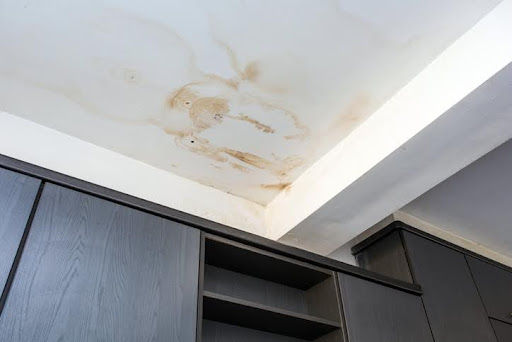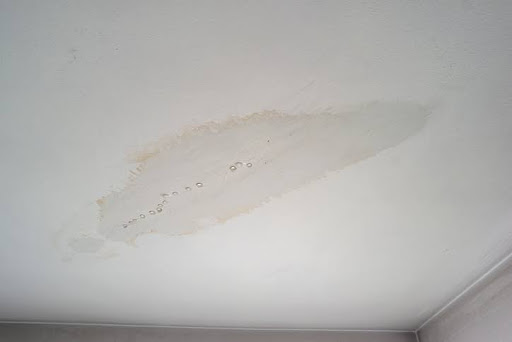Why Are There Brown Spots and Water Stains on My Ceiling? Causes and Fixes

If you’ve noticed brown spots on the ceiling or water stains that seem to be spreading or darkening over time, you’re likely dealing with a hidden leak or moisture issue. While they may appear as simple cosmetic problems, these stains are often a sign of water intrusion that could lead to more serious damage. Ignoring the issue can result in expensive repairs or even structural harm to your home. Understanding the causes of a water spot on the ceiling and how to fix it is crucial for maintaining your home’s safety and integrity.
Common Causes of Brown Spots and Water Stains on Ceilings
1. Leaking Roof
One of the most common causes of water stains on ceilings is a leaking roof. Over time, your roof can deteriorate due to exposure to the elements, such as rain, wind, and even hail. When shingles crack or become damaged, they expose the underlayment, allowing water to seep into your attic and eventually drip down onto your ceiling.
Water leaking through the roof will often leave dark spots on the ceiling, and you may notice the stains growing larger after heavy rainfall. The water typically travels through the roof, then along beams and insulation, before dripping onto the drywall or ceiling tiles below. Roof leaks can stem from issues like missing shingles, cracked flashing around vents, or holes caused by falling debris. If your roof is leaking, contact King Roofing today for a fast and reliable roof repair.
2. Poorly Installed Skylights or Vents
Skylights and vents are other common areas where water can enter your home. These features require careful installation and regular maintenance to remain watertight. If the seals around these structures break down over time or if the installation is flawed, to begin with, water can seep through these vulnerable areas. Over time, this can lead to brown spots on the ceiling near these features. For skylights, poor insulation or cracks in the glass may also contribute to the problem.
3. Clogged Gutters and Downspouts
A less obvious culprit behind a water spot on the ceiling may be your gutters. Gutters are designed to direct rainwater away from your roof and foundation, but when they become clogged with leaves, twigs, or other debris, they can overflow. Water that overflows from clogged gutters may find its way under your shingles, leading to leaks and resulting in water stains inside your home. Additionally, improper gutter installation or damage to the downspouts can exacerbate the issue.
4. Leaking Plumbing Pipes
Leaks from plumbing pipes in your walls or ceiling can also cause unsightly brown spots on ceilings. If you have noticed stains beneath your kitchen, bathroom, or laundry room, a pipe in your ceiling or walls is likely leaking. Plumbing leaks can stem from deteriorating pipe joints, clogged drains, or corroded seals around fixtures such as faucets, toilets, or bathtubs. Often, these leaks go unnoticed until the water starts to cause visible damage in the form of water stains or mold growth on your ceiling.
5. AC System Leaks
Your AC system is another possible source of water stains on the ceiling. This typically occurs if the drip pan, which collects condensation, becomes clogged or overflows. A malfunctioning AC system can also leak water into the ceiling if the installation is flawed or if there are issues with the drain line. If your AC unit is located on the roof, improper drainage can lead to dark spots on the ceiling as water leaks down through the ceiling tiles or drywall.
6. Attic Condensation
Condensation in the attic is another frequent cause of brown spots on the ceiling. Warm, humid air from inside your home rises into the attic, where it can meet cooler surfaces. When the warm air cools rapidly in the uninsulated attic, moisture forms, creating condensation that can damage the roofing materials and lead to leaks. Over time, the excess moisture can also lead to mold growth, which will leave visible stains on the ceiling. Proper attic ventilation and insulation can help prevent this problem.
7. Mold and Cigarette Smoke
In some cases, brown spots on the ceiling may not be the result of a water leak at all but instead a sign of mold growth or smoke stains. Mold thrives in areas with poor ventilation, such as bathrooms or kitchens, where moisture is common. If humidity is not adequately controlled, condensation can accumulate on surfaces, leading to mold formation. Mold on the ceiling may appear as dark spots on the ceiling, and its presence can lead to serious health issues if not addressed. Cigarette smoke can also leave yellow-brown stains on the ceiling, though these stains are not typically associated with water intrusion.
Why Brown Spots and Water Stains on Ceilings Shouldn’t Be Ignored

Ignoring brown spots on the ceiling can lead to significant problems down the line. Here are some key reasons why you should address water stains immediately:
1. Structural Damage
Water intrusion weakens structural components like wood beams, insulation, and drywall. Over time, this can compromise the integrity of your home’s structure, leading to costly repairs or even the risk of collapse if left untreated. Additionally, persistent water damage can result in the growth of mold, which further deteriorates materials and makes the problem harder to fix.
2. Electrical Hazards
Water leaking near electrical wires poses a severe risk of electrical fires. Moisture can cause wires to short-circuit or lead to corrosion of electrical components. A small leak near electrical wiring can quickly escalate into a fire hazard if not dealt with promptly.
3. Health Risks from Mold and Bacteria
Water stains that persist on the ceiling can be a breeding ground for mold and bacteria. These contaminants not only cause unpleasant odors but can also affect indoor air quality and cause respiratory problems for inhabitants, especially in high-humidity areas like bathrooms and kitchens.
4. Increased Repair Costs
The longer you wait to address the problem, the more expensive it will be to repair. Water damage tends to worsen over time, leading to larger stains, more extensive ceiling damage, and potentially affecting other parts of your home, including walls and floors. Prompt repairs can save you a significant amount of money in the long run.
How to Fix Brown Spots and Water Stains on Ceilings
1. Identify the Source of the Leak
Before you can address the water stain on your ceiling, you must first determine the cause of the leak. This is essential for ensuring that the problem is resolved properly and doesn’t return. Inspect your roof for missing shingles or damaged flashing, check for plumbing issues, and evaluate your AC system and gutters. If you’re unsure of the source, it’s best to call a professional roofer or plumber to conduct a thorough inspection.
2. Temporary Measures to Contain the Leak
While you wait for professional repairs, you can take some temporary steps to minimize the damage. If water is actively leaking, use a tarp to cover the affected area or place a bucket underneath to catch drips. In the case of a plumbing leak, turn off the water supply to prevent further damage.
3. Repairing the Leak
Depending on the source, repairing the leak may involve patching up your roof, fixing plumbing pipes, or addressing AC system issues. Roof repairs can range from simple patch jobs to full roof replacements, while plumbing and AC leaks may require part replacements or system servicing. For best results, hire a licensed professional to ensure the repair is done correctly and that the issue doesn’t recur.
4. Fixing the Ceiling Stains
Once the leak is resolved, you can address the water stains on the ceiling. If the stains are minor, a mixture of bleach and water can help clean them. For larger stains, you may need to replace the affected drywall or ceiling tiles. If you’re dealing with a wood ceiling, sanding down the affected area and resealing it may restore its appearance. After cleaning or replacing the ceiling material, you may want to repaint the area to restore the appearance of your ceiling. It’s recommended that you contact a professional for these repairs.
5. Preventative Measures
To avoid future issues, it’s important to take preventive steps such as regular roof inspections, gutter cleaning, and proper attic insulation. Installing or upgrading your AC system and ensuring good ventilation in areas prone to condensation will help minimize the risk of moisture-related stains.
Prevent Future Water Stains
Preventing brown spots on your ceiling and water stains is much easier than dealing with the aftermath of leaks and water damage. Regular home maintenance, early detection of leaks, and professional repairs can keep your home safe from the dangers of water damage. If you’re concerned about water spots on your ceiling in Naples Florida, don’t hesitate to reach out to King Roofing at 239-598-2414 for an expert inspection and solutions to protect your home.












